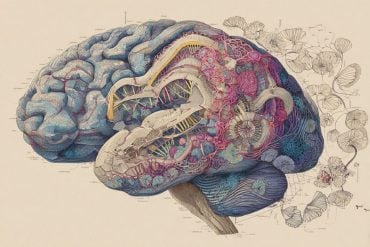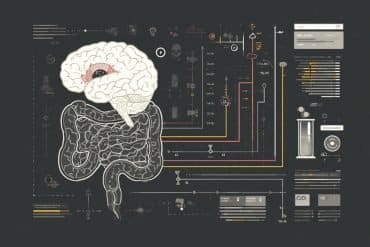Summary: Researchers report six minutes of high-intensity exercise on a regular basis can slow brain aging and delay the onset of neurodegenerative diseases such as Alzheimer’s and Parkinson’s disease. High-intensity exercise increases the production of BDNF, a protein implicated in memory, learning, and brain plasticity, which could protect the brain from age-related cognitive decline.
Source: The Physiological Society
Six minutes of high-intensity exercise could extend the lifespan of a healthy brain and delay the onset of neurodegenerative disorders, such as Alzheimer’s disease and Parkinson’s disease.
New research published in The Journal of Physiology shows that a short but intense bout of cycling increases the production of a specialized protein that is essential for brain formation, learning and memory, and could protect the brain from age-related cognitive decline.
This insight on exercise is part of the drive to develop accessible, equitable and affordable non-pharmacological approaches that anyone can adopt to promote healthy aging.
The specialized protein named brain-derived neurotrophic factor (BDNF) promotes neuroplasticity (the ability of the brain to form new connections and pathways) and the survival of neurons.
Animal studies have shown that increasing the availability of BDNF encourages the formation and storage of memories, enhances learning and overall boosts cognitive performance. These key roles and its apparent neuroprotective qualities have led to the interest in BDNF for aging research.
Lead author Travis Gibbons from University of Otago, New Zealand stated, “BDNF has shown great promise in animal models, but pharmaceutical interventions have thus far failed to safely harness the protective power of BDNF in humans.
“We saw the need to explore non-pharmacological approaches that can preserve the brain’s capacity which humans can use to naturally increase BDNF to help with healthy aging.”
To tease apart the influence of fasting and exercise on BDNF production, the researchers, from the University of Otago, New Zealand, compared the following factors to study the isolated and interactive effects:
- Fasting for 20 hours
- Light exercise (90-minute low intensity cycling)
- High-intensity exercise (six-minute bout of vigorous cycling)
- Combined fasting and exercise
They found that brief but vigorous exercise was the most efficient way to increase BDNF compared to one day of fasting with or without a lengthy session of light exercise. BDNF increased by four to five-fold (396 pg L-1 to 1170 pg L-1) more compared to fasting (no change in BDNF concentration) or prolonged activity (slight increase in BDNF concentration, 336 pg L-1 to 390 pg L-1).
The cause for these differences is not yet known, and more research is needed to understand the mechanisms involved. One hypothesis is related to the cerebral substrate switch and glucose metabolism, the brain’s primary fuel source.
The cerebral substrate switch is when the brain switches its favored fuel source for another to ensure the body’s energy demands are met, for example metabolizing lactate rather than glucose during exercise. The brain’s transition from consuming glucose to lactate initiates pathways that result in elevated levels of BDNF in the blood.

The observed increase in BDNF during exercise could be due to the increased number of platelets (the smallest blood cell), which store large amounts of BDNF. The concentration of platelets circulating in the blood is more heavily influenced by exercise than fasting and increases by 20%.
Twelve physically active participants (six males, six females aged between 18 and 56 years) took part in the study. The balanced ratio of male and female participants was to provide a better representation of the population rather than indicate sex differences.
Further research is underway to delve deeper into the effects of calorie restriction and exercise to distinguish the influence on BDNF and the cognitive benefits.
Travis Gibbons noted, “We are now studying how fasting for longer durations, for example up to three days, influences BDNF. We are curious whether exercising hard at the start of a fast accelerates the beneficial effects of fasting.
“Fasting and exercise are rarely studied together. We think fasting and exercise can be used in conjunction to optimize BDNF production in the human brain.”
About this exercise and dementia research news
Author: Press Office
Source: The Physiological Society
Contact: Press Office – The Physiological Society
Image: The image is in the public domain
Original Research: Closed access.
“Fasting for 20 h does not affect exercise-induced increases in circulating BDNF in humans” by Travis Gibbons et al. Journal of Physiology
Abstract
Fasting for 20 h does not affect exercise-induced increases in circulating BDNF in humans
Intermittent fasting and exercise provide neuroprotection from age-related cognitive decline. A link between these two seemingly distinct stressors is their capability to steer the brain away from exclusively glucose metabolism. This cerebral substrate switch has been implicated in upregulating brain-derived neurotrophic factor (BDNF), a protein involved in neuroplasticity, learning and memory, and may underlie some of these neuroprotective effects.
We examined the isolated and interactive effects of (1) 20-h fasting, (2) 90-min light exercise, and (3) high-intensity exercise on peripheral venous BDNF in 12 human volunteers.
A follow-up study isolated the influence of cerebrovascular shear stress on circulating BDNF. Fasting for 20 h decreased glucose and increased ketones (P ≤ 0.0157) but had no effect on BDNF (P ≥ 0.4637). Light cycling at 25% of peak oxygen uptake (${\dot V_{{{\rm{O}}_{\rm{2}}}{\rm{peak}}}}$) increased serum BDNF by 6 ± 8% (independent of being fed or fasted) and was mediated by a 7 ± 6% increase in platelets (P < 0.0001).
Plasma BDNF was increased from 336 pg l−1 [46,626] to 390 pg l−1 [127,653] by 90-min of light cycling (P = 0.0128). Six 40-s intervals at 100% of ${\dot V_{{{\rm{O}}_{\rm{2}}}{\rm{peak}}}}$ increased plasma and serum BDNF, as well as the BDNF-per-platelet ratio 4- to 5-fold more than light exercise did (P ≤ 0.0044). Plasma BDNF was correlated with circulating lactate during the high-intensity intervals (r = 0.47, P = 0.0057), but not during light exercise (P = 0.7407).
Changes in cerebral shear stress – whether occurring naturally during exercise or induced experimentally with inspired CO2 – did not correspond with changes in BDNF (P ≥ 0.2730).
BDNF responses to low-intensity exercise are mediated by increased circulating platelets, and increasing either exercise duration or particularly intensity is required to liberate free BDNF.






